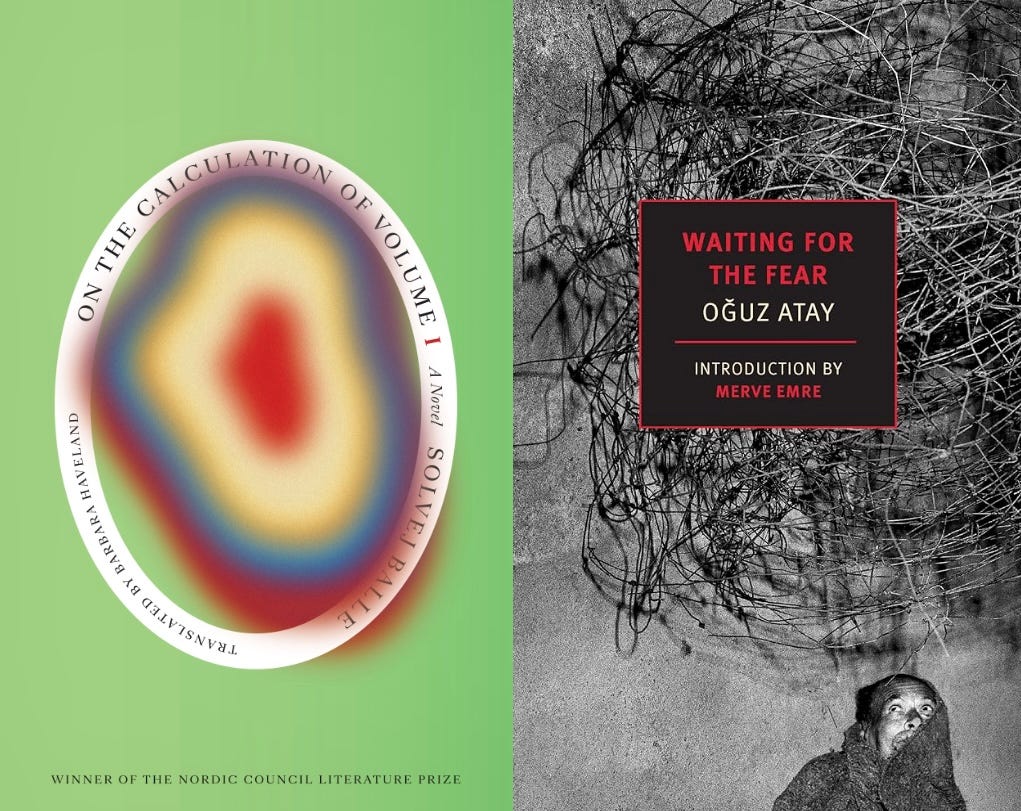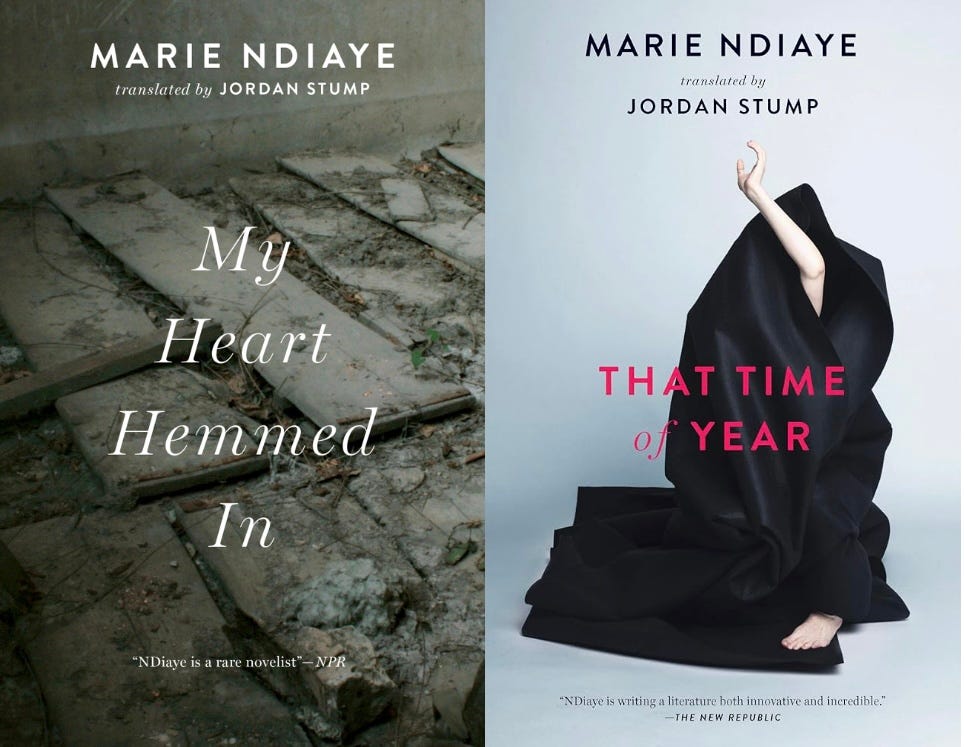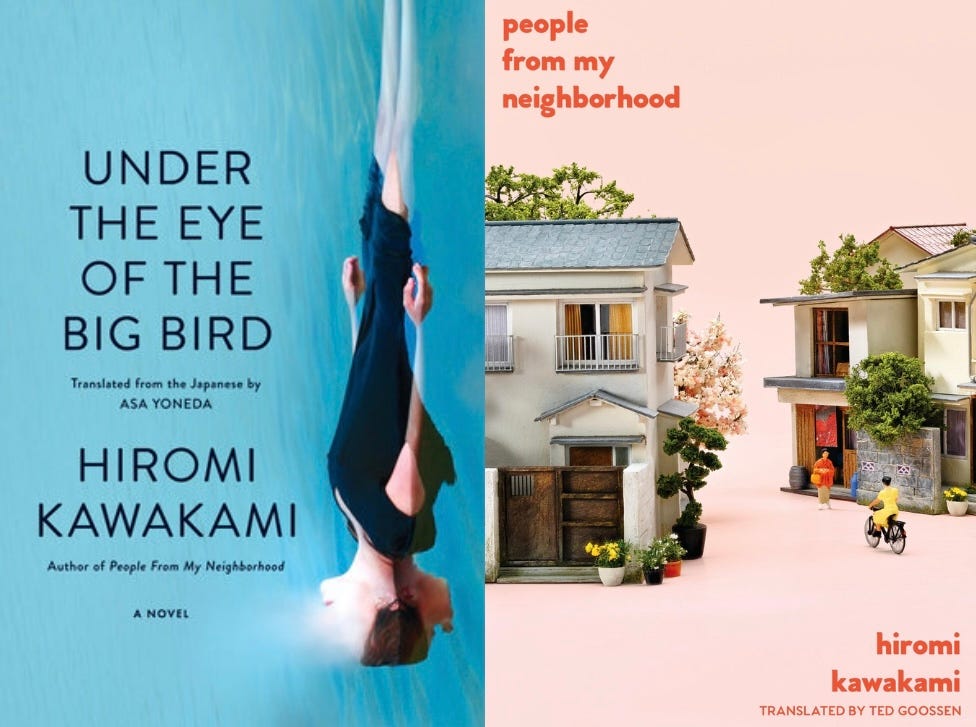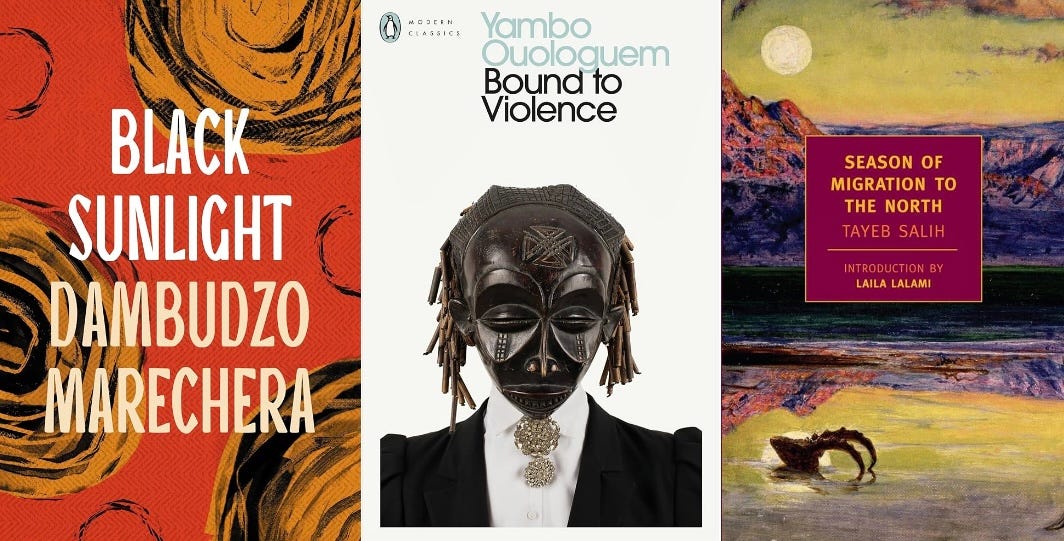Herscht 07769 by László Krasznahorkai (translated from Hungarian by Ottilie Mulzet)
Angel in the Forest by Marguerite Young
Although disparate on paper, Marguerite Young’s omniscient history of New Harmony, Indiana and László Krasznahorkai’s German novel of societal decay are both works in desperate search of harmony, whether it be that of the ideal societies conjured by George Rapp and Robert Owen or that found in the music of Bach amidst far-right terror. Young lends her impossible prose to two equally impossible visions of humanity that briefly materialized in the town of New Harmony, creating an epic of the folly of America in miniature. New Harmony as she introduces it in 1940—calm, practical, insular—is a town in league with Herscht 07769’s Kana. Beneath these towns rest the bones of ideologies buried yet not fully decayed. Both novels are written in the stench of this decay. Herscht’s final image and damning (sole) period poignantly capture the cliff this precarious century rests upon.
On the Calculation of Volume by Solvej Balle (translated from Danish by Barbara J. Haveland)
Waiting for the Fear by Oğuz Atay (translated from Turkish by Ralph Hubbell)
Oğuz Atay’s story collection and the first two volumes of Solvej Balle’s septology are two stunning visions of dread that demonstrate for English readers where literature has yet to go. In Balle’s first volume, as the narrator wakes up to the same day day after day, the stitches of time which constitute her sense of self dissolve. It is the most paranoid experience I have had as a reader. I continually had to check my surroundings, make sure objects were still in place, my partner was still beside me or nearby. Going to bed carried a pinch of dread that felt as ridiculous as it was unavoidable. Balle makes the passage of days precious, sacred, not to be taken for granted.
The titular story in Waiting for the Fear is a similar story of isolation, as a man finds himself threatened by a note in an obscure language to remain in his house or else. The irony behind the title emerges as time goes on and meaning not found in daily life arrives in the ambiguous state of waiting and fear. Any novel of isolation now feels either prescient of or in response to the pandemic. Few conjure its minute dread like these.
The Obscene Bird of Night by José Donoso (translated from Spanish by Megan McDowell, Hardie St. Martin, & Leonard Mades)
Not much compares to the intricacies and paranoias of Donoso’s body horror masterpiece. Written through the framework of the imbunche folk monster and Chile’s turbulent political history, Mudito’s story traces a labyrinth of identity through past and present, reality and hallucination, nightmare and ecstasy. Religious and sexual fervor linguistically and thematically drive this novel into uncharted territory. Aside from being one of the most impressive novels I’ve read, it’s a pure pleasure that is as comical as it is challenging. I suspect each reader will read a very different book according to their own inner labyrinths.
My Heart Hemmed In & That Time of Year by Marie NDiaye (translated from French by Jordan Stump)
NDiaye, the true heir to Kafka, is perhaps the best writer of racism that fiction has yet to see. These two novels act as modern fables where race need not be mentioned, for its effect on the mind and body are evident. In My Heart Hemmed In, a couple who both teach in rural France find themselves one day despised by everyone. Ndiaye depicts a hatred so intrinsic that those who carry it do so without fully understanding it:
“There’s nothing special about you and your husband. It’s not you, not exactly you that this ugliness is attacking, and besides, who around here even knows you? Apart from a few people, who, like me… But no, it’s not you, it’s… how can I put it… the untouchability of what you are, your…your stiffness, your purity, your manner, your habits, oh, how can I put it…”
“We’re exactly like you,” I say.
“So you think,” she says, “but oh God, you don’t understand, and I don’t know how to… You’re so different, so profoundly… excessive, but either you don’t know it or, who knows, you refuse to see it, although, once again, this isn’t exactly about you as such, and… and the disgust and hostility you inspire in some people, not me, oh not me, is something you can’t feel toward yourselves, at least not yet,”
That Time of Year, while not as ambitious as My Heart Hemmed In, is a sister text, depicting a man who stays a day longer than usual on his annual family vacation in rural France only to find his wife and child missing and the town’s attitude to be completely changed. NDiaye is a writer who proves story to be clearer than any argument, any attempt at nonfiction, and is one whose gift of implicitness should inspire change in the way our stories conceive and depict of race, hate, and difference.
Under the Eye of the Big Bird & People From My Neighborhood by Hiromi Kawakami (translated from Japanese by Asa Yoneda and Ted Goossen)
A quarter into the century we find a global contemporary literature exemplified by novels such as Hurricane Season, The Employees, and Herscht 07769. Under the Eye of the Big Bird, this era’s speculative fiction masterpiece, has its eye on humanity as a whole. Kawakami does not take many of humanity’s attributes for granted. Several of the stories here read as if they could take place at any moment in human history. What emerge as constants in this study of human behavior are only the essential: love, family, friendship, and the myriad ways in which the mind processes the pleasures and pains of being. The biological and cultural forms in which these essentials manifest evolve over the course of millennia, ending in a tale of family and creation that serves as an origin story for a world we can hardly imagine.
Kawakami is a writer in tune with the oldest of human stories and passions, as evidenced by People From my Neighborhood, a collection of palm-of-the-hand stories about a single town. These carry all the brevity, drama, and aura of folktales and oral storytelling. Like in Under the Eye of the Big Bird, apocalyptic scenes are reset when another story appears in the same setting but later on, or before, the apocalypse seemingly always put off or right at hand. Kawakami shows humanity’s beauty to be its ability to evolve no matter the cost.
Frontier by Can Xue (translated from Chinese by Karen Gernant & Chen Zeping)
The fiction of Can Xue (at this point an honorary Nobel laureate) is a necessary reset of all the form’s assumptions. The signature simplicity of her prose belies the strangeness of the events depicted. One is never too sure of one’s perceptions, nor of those around them, and the predictability of day to day life can shift as quick as a whim. The singularity and mastery of Xue’s voice is apparent in both her short stories and her novels. However, one feels her wings spread fully when given the long range of a novel like Frontier. Xue’s stories are communal, interested in relationships that sustain themselves despite external confusion and turmoil. One finds oneself pressed to describe her work, its effect so dependent on the experiential. I’ve written about her forthcoming story collection Mother River here.
Ti Amo & Stay With Me by Hanne Ørstavik (translated from Norwegian by Martin Aitken)
Literature’s patron saint of love, Hanne Ørstavik’s Ti Amo and Stay With Me are a two volume epic of love’s lifecycles between birth, death, and rebirth. There is no artifice here, no project beyond a pure and honest reckoning with the most essential human problem. Ørstavik writes with a similar purity of prose and intent as an Annie Ernaux, but surpasses her and similar writers here in both.
Black Sunlight by Dambudzo Marechera
Bound to Violence by Yambo Ouologuem (translated from French by Ralph Manheim)
Season of Migration to the North by Tayeb Salih (translated from Arabic by Denys Johnson-Davies)
The experience of reading these three postcolonial epics in close proximity to one another in 2024 colored everything else I read afterward. These characters return from Europe to their homes in Zimbabwe, Mali, and Sudan with economic and educational resources at the cost of cultural disconnection. Dambudzo Marechera, one of the English language’s most underrated prose stylists, captures the nature of this violence in both the form and content of his work. His prose is knife like, his dialogue philosophical and hedonistic. A writer long overdue for a revival in interest.
“ ‘About violence? It is impossible to “feel” about violence. Impossible to “think” about violence, and kinds of violence. Of course there are degrees of violence, and kinds of violence. There is a violence in the very attempt to write in such a way that the writing is beyond thought and feeling. Personally I find that our feelings and thoughts are themselves a kind of self-violation, a self-immolation. It is this inherent quality of our feelings and thoughts which I find to be more significant than the thing thought or the thing felt. More significant because it is unmoving and permanent and has, as it were, a corporate almost archetypal solidity and its resonance has a ring that goes beyond poetry.’ ”
Yambo Ouologuem is a writer in league with Marechera’s project, but whereas Marechera’s brilliance is spread out among fragmented novels, stories, poetry, and plays, Ouologuem’s is housed in the sole novel Bound to Violence. It is a Malian epic with resonance of the oral storytelling tradition of Sunjata, written with a language that dances and flickers as if on fire, painting a portrait of a lineage of violence from antiquity to the postcolonial age.
Tayeb Salih’s Season of Migration to the North is a calmer novel, sharing the same concerns as Bound to Violence and Black Sunlight but with a measure of repose and resignation. Where Ouologuem and Marechera push language to its breaking point in order to break new ground on the subjects at hand, Salih paints a vast, all-encompassing canvas for the viewer to take in as they may. One finds in this novel a view not dissimilar to Hiromi Kawakami’s:
Over there is like here, neither better nor worse. But I am from here, just as the date palm standing in the courtyard of our house has grown in our house and not in anyone else’s. The fact that they come to our land, I know not why, does that mean that we should poison our present and our future? Sooner or later they will leave our country, just as many people throughout history left many countries. The railways, ships, hospitals, factories and schools will be ours and we’ll speak their language without either a sense of guilt or a sense of gratitude. Once again we shall be as we were—ordinary people—and if we are lies we shall be lies of our own making.
Forthcoming books on my radar:
There Lives a Young Girl in Me Who Will Not Die — Tove Ditlevsen
Voices of the Fallen Heroes and Other Stories — Yukio Mishima
World Within the World: Collexted Minicomix & Short Works 2010-2022 — Julia Gfrorer
Dysphoria Mundi: A Diary of Planetary Transition — Paul B. Preciado
Crossings: “Varied Imagination” and “Living Between Languages” — Sylvia Molloy
Garden — Hiroko Oyamada
A Girl Is Lost in Her Century, Looking for Her Father — Gonçalo M. Tavares
Strange and Perfect Account from the Permafrost — Donald Niedekker













You always have the best taste in books! Always get good recs from reading your posts!
I don't have much time to find out on what books are worth reading, so this list is truely valuable. I've added half of these to my reading list. Happy new year!